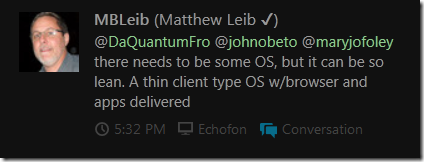Is the dawn of thin client computing upon us?
I cannot disagree more strenuously with the above statement.
Why?
It is based on three points, which, while reasonable, are actually anecdotal, and not supported by the facts.
Point 1) That thin clients can do everything. They cannot. If they could, #Wyse would rule the world now. In their own place, thin clients shine. But as everyday systems for regular folks, they are inadequate, and woefully so. When power-intensive tasks do need to be performed, these thin clients fall short. Which brings us to
Point 2) It presumes the universal availability of speedy bandwidth. This is not so. Bandwidth is at a premium. I happen to know this firsthand: I reside in an area where there isn’t any sort of truly high-speed internet access, mobile or static. As a result, I am able to form an opinion as to this point. We do not have universal high speed broadband yet. Worse than that, we do not have affordable broadband to the extent that it would be advisable to end users to move en masse to thin clients.
Point 3) It assumes that the cloud is infallible. That is simply not the case. Time after time, the cloud has failed us. We take it in stride because most of the cloud-delivered apps or content we consume are free. Now flip the script, and come over the the spot where a cloud-delivered app you as a consumer or your business needs is offline. You/all your employees cannot work. Would you be happy if the cloud-app, at that crucial moment breaks out in Kool Moe Dee’s signature riff, “How You Like Me Now?”
Even lightweight platforms – read that as mobiles – have mostly local apps delivering the goodies. From a customer satisfaction standpoint, thin clients for general-purpose computing will not work.
So far, there have been two attempts to bring thin clients to users’ consciousness: the netbook, and the Chromenetbook. Both failed. Since, you know, no one wants them.
Another thing why it won’t work: we have been here before: remember the MITS Altair 8800? That was a thin client. So was the Timex Sinclair Z80. They were barely functional, and once we determined that, we rejected them. Which started us on the march to where we are now.
Moreover, no one is talking about the massive management framework needed to support a horde of thin clients. No one. It is one thing to support a few apps mostly sued by power users and the noisome punditry, it is quite another to have actual users depend on these things for their everyday computing lives.
Finally, while sexy, this idea is going nowhere. It simply won’t take off. I hate to say it, but even if you strap the thin client idea with multiple high-yield thermonuclear devices, like a failed martyr, it won’t blow up!
Follow @johnobeto
